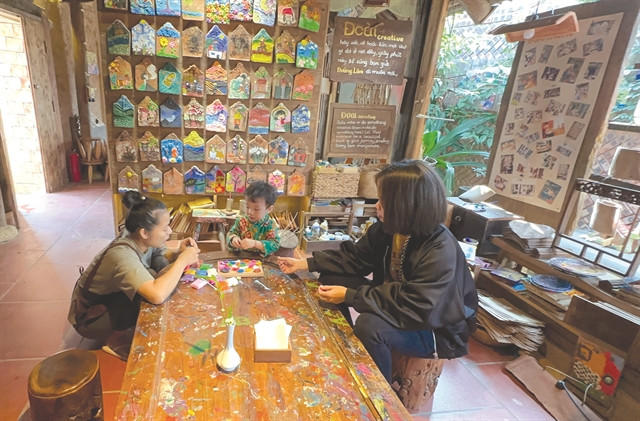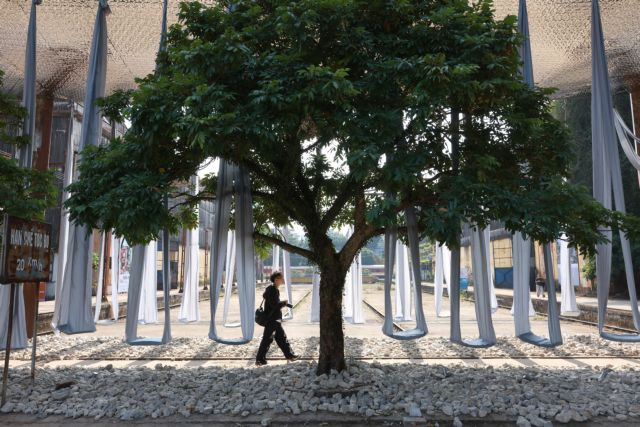Visiting the village, people can enjoy various creative spaces run by architects and artists. These spaces have added new contemporary breath into the countryside peace, inspiring young generations, locals and foreign tourists.
Architect Khuất Văn Thắng has converted a dilapidated shophouse into a venue called Đoài Creative to host activities like painting, ceramics, professional workshops, and creative camps.
“I think Đường Lâm is a representative of the cultural value of the northern region,” he told Việt Nam News. “Here there is a stock of heritage and multiple stories that many people do not know yet. This is the force for me to set up this arty space to introduce local values.”
Đoài Creative is a living space of creativity, developed every day here through tourists, fine art students, and children visiting Đường Lâm. They can all sit in the house and create something based on local stories.
“Đoài Creative has still/silent and moving spaces. The silent space is aimed at people who can spend several days here to create artworks,” Thắng said.
The house's second floor is like a camp for artists, while the first floor is for drawing classes for children on Saturday mornings.
 |
| CREATIVE CORNER: People of all ages can find their creative corner at Đoài Creative. VNS Photo Lê Hương |
A few hundred metres from Thắng’s premises is an art café run by lacquer painter Nguyễn Tấn Phát, where he displays paintings and hosts workshops.
“This is the second art space I opened to use the art I learned and restore fading local traditional handicrafts,” Phát said.
“This space is more for the community, which displays artworks of painters based in Sơn Tây Town. Here people can try to make ceramics. Local Lò Nồi ceramics died some 40 years ago. With my skills, I can remind people of the lost craft. I believe the art and craft space here will help enliven the heritage of the area.”
Phát welcomes locals and tourists to his art space.
“My main purpose is not to make money,” he said. “I have trained more than 100 people in lacquer art so far, for free. I think this is a real contribution to the community.”
Kim Hải Long, a visitor from Vĩnh Phúc Province, visits the village three to four times each week
“In Đường Lâm, I can find a tranquil atmosphere,” he said. “When I step into the village’s gate, I feel more relaxed from the outside hustle and bustle.
 |
| ARTS AND CRAFTS: Foreign tourists enjoy Nguyễn Tấn Phát's lacquer lessons. Photo courtesy of the artist |
“I had limited access to ceramics and paintings before. But now I have much more experience in art. I may bring my children here soon.”
Local authorities have encouraged those art activities to draw more tourists.
Nguyễn Đăng Thạo, head of Đường Lâm Village Relics Management Board, said that besides developing tourism products like spiritual tourism and heritage tourism, they had a plan to develop creative spaces.
“We hope to develop creative spaces together with heritage sites. We are setting up various creative spaces for artisans, architects, and ancient village lovers,” Thạo said.
He said Đường Lâm would always welcome artisans and artists near and far to visit and work at the village.
Thắng and Phát are not local residents. They come and stay as they love the village.
“We have facilitated them in PR so that they can bring art products to visitors to the village,” Thạo said.
Creative capital
Besides Đường Lâm in Sơn Tây, every district in the capital city has joined in various creative activities.
 |
| SCHOOL TRIP: Children visit Gia Lâm Train Factory, which was turned into a creative space recently. VNS Photo Trương Vị |
After four years of joining the Creative Cities Network of UNESCO, Hà Nội is gradually working towards a ‘’Creative City’’ title.
The authorities have issued a resolution on developing the culture industry in the capital in 2021-25, and are also implementing initiatives to join the Creative Cities Network by UNESCO by 2050. The city has also hosted multiple programmes and activities to realise commitments with the UN culture organisation.
The city has organised many contests on design, and many activities have been organised across the city, such as at Art Centre at 22 Hàng Buồm Street, Hoàn Kiếm Pedestrian Zone, Trịnh Công Sơn Pedestrian Street, and Sơn Tây Ancient Citadel.
 |
| INDUSTRIAL: Art installation inside a workshop at the factory. VNS Photo Trương Vị |
According to Đỗ Đình Hồng, director of Hà Nội Culture & Sports Department, three years after the first Hà Nội Creative Design Festival was organised, the scale and quality of the festival have grown rapidly, gathering thousands of artists across the country.
This year, the festival had 60 activities in total with four architecture designs introduced; 20 exhibitions, 20 seminars including five international ones, and nine community art events.
This year’s festival gathered over 200 units and individuals in the creative field.
“Hà Nội is playing a key role in moving towards her trademark ‘Creative City’ status, with various open policies and setting up various creative spaces to draw tourists,” Hồng said.
 |
| NEW USE: An abandoned factory can be a creative space for artists. VNS Photo Trương Vị |
Utilising industrial heritage
Highlights of the festival were art installations at Gia Lâm Train Factory and Hàng Đậu Water Tower, which has been deserted for years.
Architect Nguyễn Hồng Quang, who was responsible for forming architectural spaces in the festival, said: “We have to turn the abandoned factory into art spaces and brought them alive with dozens of exhibitions and art performances.”
The Việt Nam Railways Corporation even launched a train service from Long Biên Station to Gia Lâm Station to bring guests from inner Hà Nội to Gia Lâm Train Factory for the occasion.
 |
| ALFRESCO ART: A visitor passes an art installation at Gia Lâm Train Factory. VNS Photo Trương Vị |
The special train service had an art space for artists to perform.
Hoàng Năng Khang, deputy director of the corporation, said they would launch more such train service for tourists.
Designer Nguyễn Thị Nga thinks the festival is now more professional with a larger scale.
“This is a big chance for designers and artists to express their desire to do something for Hà Nội as a city with centuries long tradition, but energetic and creative at the same time,” said Nga, who designed traditional costumes for a fashion show at the festival.
 |
| REPURPOSED: Industrial relic sites can be ideal places for art projects. VNS Photo Trương Vị |
Long way to go
The creative community in Hà Nội needs more spaces for creative ideas. Many think old factories in the city are feasible places for such purposes.
Trương Minh Tiến, chairman of Hà Nội’s UNESCO Association, said adaptive preservation should be applied to separate heritage sites.
“We can keep the sites as museums but also host activities there suitable to the sites’ characteristics to draw visitors,” he said.
Lê Quang Bình, co-ordinator of the For A Living Worthy Hà Nội network, said instead of demolishing such factories to build high-rises, we can create spaces for trade, creativity, and entertainment.
“I think it’s a better idea in terms of environment, culture and finance as well,” he said.
 |
| FAMED SITE: Hàng Đậu Water Tower has been turned into a space for art installations. VNS Photo Trương Vị |
Phạm Thanh Hường, head of the Culture Department of the UNESCO Office in Hà Nội, said that the authorities and agencies should pay more attention to how to manage such public property.
John Peto, from Nerve Centre Multi Media Arts in the UK, said he was impressed with the enthusiasm of the creative community in Việt Nam.
"There are so many young artists with many big ideas to do things," he said.
"You can see that enthusiasm, that energy and talent is the hard part of building a creative community in a creative city. But they need more support from local authorities to be able to come together and collaborate to develop, so that they can start to become more productive to drive the city economically and culturally.
 |
| ARCHITECTURAL ICON: The 19th-century Hàng Đậu Water Tower is now a valuable heritage site in the capital city. |
"That goodwill and energy is essential. It's about getting a space for young people to come together, to have proper spaces for their creations.”
Architect Đoàn Kỳ Thanh said his team had examined many locations to open creative spaces for Hà Nội.
“We have proposed the authorities build creative centres and art districts for Hà Nội,” he said. “There are, however, many obstacles.”
International experts have also suggested nine abandoned old factories in the inner city as suitable places for creative work. VNS